A Second Original Painting by Poussin Discovered
with the Tomb Portrayed in The Shepherds of Arcadia
The Discovery of the Engraving in 2007
In April 2007 I published on this web page my discovery of an engraving created by an anonymous artist, after the example of an until then unknown painting "Rest on the Flight to Egypt with Elephant" by the French master Nicolas Poussin (1594-1665).
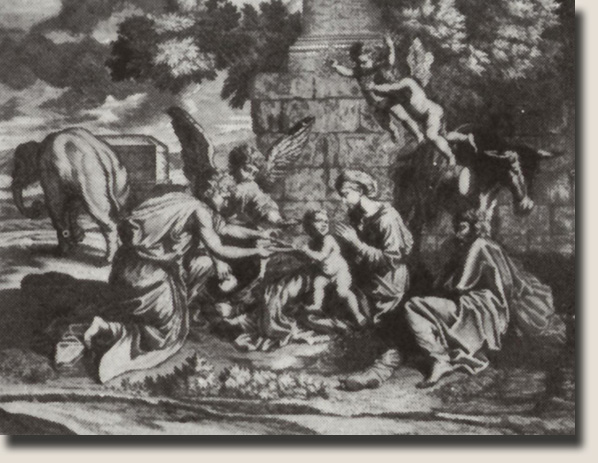
The engraving by an anonymous artist after the example of
"Rest on the Flight to Egypt with Elephant" by Nicolas Poussin
(Photo © Thuillier 1974)
The engraving depicts a rather common tableau in the world of art: after they were warned by an angel that king Herod sent out a kill order for all newborn boys, Joseph, Mary and the newborn Jesus temporarily left their homeland to flee to Egypt. The work of art portrays a rest during that flight.
Nothing particularly remarkable were it not that this engraving depicted the same tomb that Poussin had portrayed in his famous work "The Shepherds of Arcadia II". This engraving with this second tomb was at the moment in 2007 still unknown in the small world of Rennes-le-Château.
Many years after I was contacted via e-mail by David Pybus an other Rennes-le-Château enthusiast, who informed me of the existance of an other similar engraving. This engraving was made in 1787 by the Italian engraver Raffaello Morghen also after the example of Poussin's missing painting. This second engraving currently resides in the National Galleries of Scotland. As a matter of fact Morghen's engraving definitely confirmed that the object in the painting was the same tomb als depicted in "The Shepherds of Arcadia II", as there still was some uncertainty about it due to the small picture of the first engraving that I discovered.
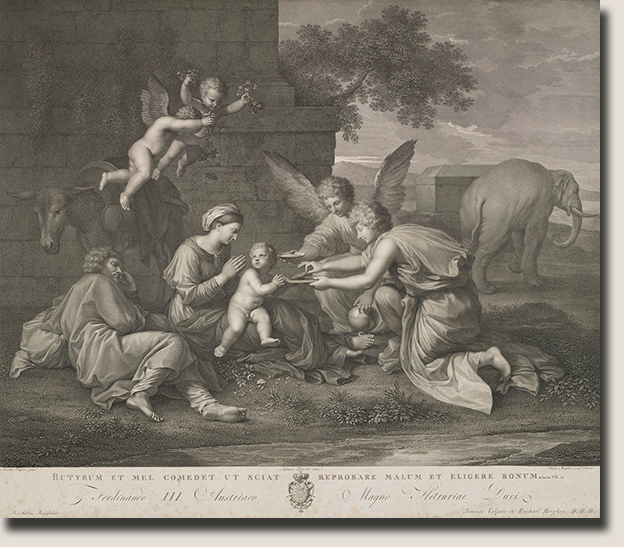
The engraving by the Italian artist Raffaello Morghen
after the example of Nicolas Poussin's missing painting
(Photo © National Galleries Scotland)
After 2007 Poussin's original painting remained missing. Nothing was known about the current owner or the whereabouts of the painting, on which the two engravings were based. According to various art connoisseurs this masterpiece had disappeared or was considered lost in history. In the meantime after fifteen years of searching I finally rediscovered Poussin's original painting.
The Article "Poussin's Elephant" by Professor Rice
At the end of 2021 I discovered the very interesting article "Poussin's Elephant", written by Louise Rice, an American Associate Professor in Art History at the University of New York.
In the article the art historian described how she could date Nicolas Poussin's painting "Hannibal Crossing the Alps more accurately, after rediscovering some documents that were written on a particular event. As of the year 1626 a fairground attraction group travelled through European cities to entertain the crowd with an Indian elephant, named "Don Diego".
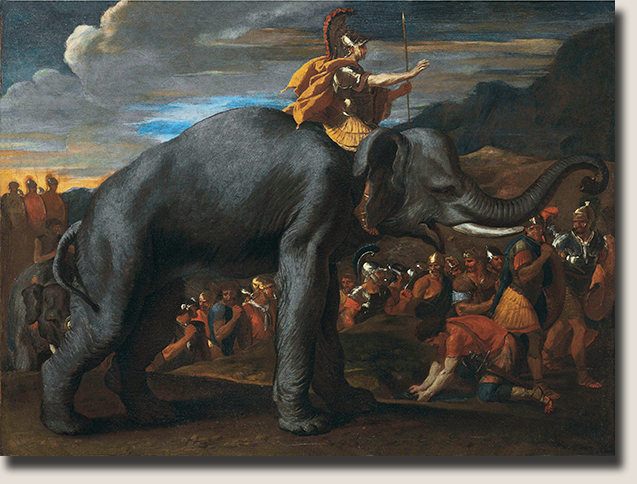
"Hannibal Crossing the Alps" van Nicolas Poussin
During the years 1626-1627 Don Diego travelled through France as a fairground attraction. In 1628 the touring group of the elephant visited the cities of Ghent and Antwerp in Flanders, where the Flemish artist Peter Paul Rubens also observed the animal withj his own eyes. Soon after they arrived in the Dutch city of Utrecht. In 1629 elephant travelled through several German cities. Every city Don Diego came around, the impressive beast brought a big crowd of people together.
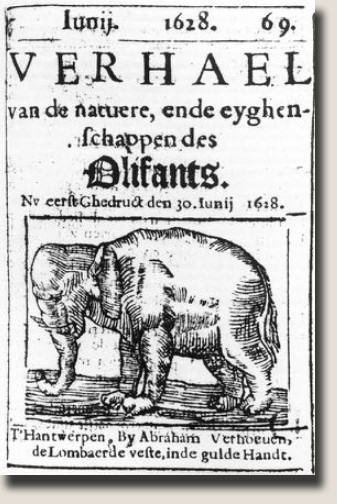
A woodcut retelling the visit of the elephant Don Diego in Antwerp in 1628
(Photo Louise Rice 2017 - "Poussin's Elephant" - from "Nieuwe Tijdinghen", 30 June 1628)
In the second week of May 1630 Don Diego also arrived in Rome. A lot of people gathered to see the elephant in the Italian capital too, including the French master Nicolas Poussin, who already lived in Rome for several years by then. Poussin also wasn't the only artist who came to study the animal over there.
Based on this information Professor Rice could conclude that Poussin's painting "Hannibal Crossing the Alps" never could have been painted around 1625-1627 as was widely accepted by art historians, but only after the middle of the year 1630.
At the very end of her article's conclusion Professor Rice discussed that the elephant left little impression on Poussin's future work, although there was one remarkable exception.
To my great joy Professor Rice surprisingly described that Poussin created an other striking painting with an elephant commissioned by his patron the Italian cardinal Giulio Rospigliosi (1600-1669), who later became Pope Clement IX. That particular painting was "Rest on the Flight to Egypt with Elephant".
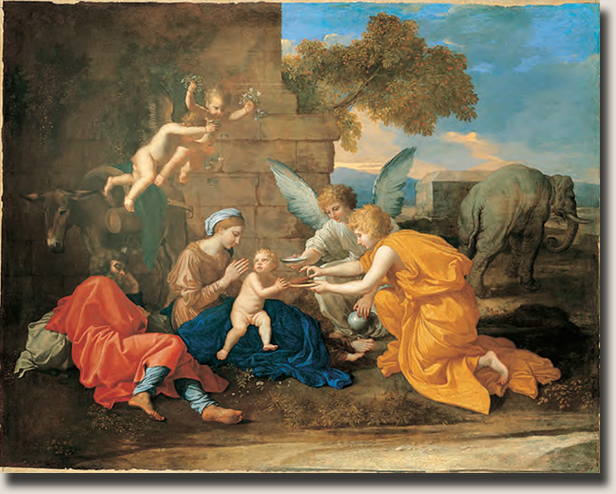
The original painting "Rest on the Flight to Egypt with Elephant" by Nicolas Poussin
(Photo © Louise Rice 2017 - "Poussin's Elephant")
Professor Louise Rice confirmed my earlier findings that this masterpiece was lost in history for a long time, but that it had only recently been rediscovered.
Even though Professor Rice is unaware of the mystery of Rennes-le-Château and the similarity with the tomb of Les Pontils, she also made the link in her article with the other tomb depicted in the second version of "Et in Arcadia Ego", with which she meant "The Shepherds of Arcadia". According to the Professor the resemblance of the monuments in these two paintings is 'haunting and mysterious' and what Poussin meant by it, we will probably never know.
History and Details of the Painting
What do we currently know about the painting "Rest on the Flight to Egypt with Elephant" by Nicolas Poussin?
It is remarkable that "Rest on the Flight to Egypt with Elephant" was painted between 1635 and 1640 by the same person, namely the Italian cardinal Giulio Rospigliosi. This catholic clergyman, who would even become Pope Clement IX in his later life as mentioned before, also ordered Poussin to paint "The Shepherds of Arcadia II".
Concerning the dating of these two paintings: We know that "The Shepherds of Arcadia II" was made around 1639-1640. The following hypothetical questions then come to mind: Did these two paintings perhaps belong to the same cardinal's order? Given the fact that the dimensions of the paintings are also practically the same, maybe they possibly formed a diptych? But there is no proof for that at all.
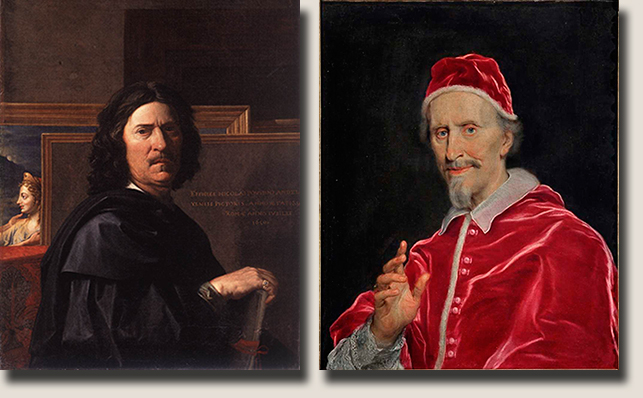
The French painter Nicolas Poussin and the Italian cardinal Giulio Rospigliosi
Rospigliosi was Poussin's patron for both paintings
After the death of cardinal Rospigliosi in 1669 the painting "Rest on the Flight to Egypt with Elephant" remained property of the family Rospigliosi until the end of the 18th century. At the beginning of the 19th century the Rospigliosifamily put the painting for sale and around 1803 "Rest on the Flight to Egypt with Elephant" was purchased, together with two other Poussin paintings, by the the French art collecting cardinal Joseph Fesch.
When cardinal Fesch died, his gigantic collection of 22000 paintings, was put up for auction on 17 March 1845 in Rome. "Rest on the Flight to Egypt with Elephant" was sold for 1700 ecu to a certain man named George, the curator expert of the Royal Louvre Museum and who actually purchased the painting in the name of an anonymous man.
Around 1864 the canvas belonged to the Forcade collection. On 2 April 1873 it was put up for sale again in Paris. It is possible that the work of art belonged to the Chennevières-Pointel collection, but from that moment on a dead end is reached in our pursuit of the painting.
Anno 2022 "Rest on the Flight to Egypt with Elephant" resides in the private collection of a French family since 1996. Currently we cannot admire this exquisite painting in a museum, but Professor Louise Rice was able to contact the owner of the painting, who generously provided her a photo of the painting.
Recently I also noticed that the auction house Drouot rediscovered the painting in April 2022 on this page of their website.Recently I also noticed that the French auction house Hôtel Drouot rediscovered the painting in April 2022 on this page of their website.
Now let us sort out the facts of the most relevant information we gathered about "The Shepherds of Arcadia II" and Rest on the Flight to Egypt with Elephant:
| Artwork | The Shepherds of Arcadia II | Rest on the Flight to Egypt with Elephant |
|---|---|---|
| Patron | Cardinal Giulio Rospigliosi | Cardinal Giulio Rospigliosi |
| Year of Production | 1639-1640 | 1635-1640 |
| Dimensions | 85 cm x 121 cm (Framed) | 84 cm x 108 cm |
| Current Whereabouts | The Louvre | Private collection of a French family |
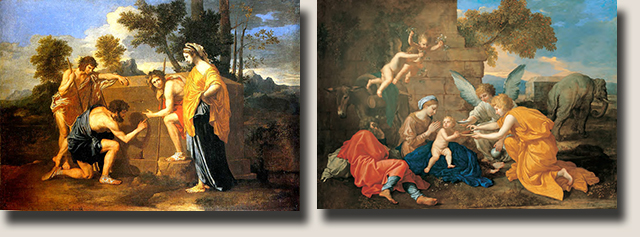
"The Shepherds of Arcadia II" and "Rest on the Flight to Egypt with Elephant"
Implications for the Mystery of Rennes-le-Château
We now know for certain that Poussin made a second painting with the same monument as portrayed in "The Shepherds of Arcadia II". But what are now its implications for for the mystery of Rennes-le-Château and the tomb in Les Pontils?
The tomb of Les Pontils was probably already known by the local residents of the village, but it was only associated with the mystery of Rennes-le-Château after its discovery in 1971 by the French researcher and treasure hunter Jean Pellet (1931-2012).
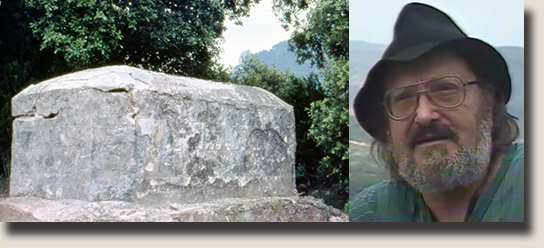
The tomb of Les Pontils and Jean Pellet (1931-2012)
After the publication of Pellet's discovery in his article "Promenade initiatique dans les gorges de l'Aude" (published in issue 9 of Grand-Albert) in collaboration with Gérard de Sède in July 1972, it was assumed for quite a while that Nicolas Poussin must have visited the region and painted the mountainous landscape (Cardou, Blanchefort and the Rennes-le-Château hilltop) and the tomb in Les Pontils.
From then on for many people the Les Pontils tomb was a part of the greater mystery around the priest Bérenger Saunière, even though his biographers stated clearly from the very beginning that Nicolas Poussin had never been in this southeastern part of France.
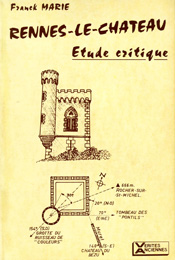
Rennes-le-Château Etude Critique
Franck Marie 1978
Later research published by Franck Marie in his book "Rennes-le-Château Etude Critique" in 1978 revealed that the monument at Les Pontils was only erected in the early 1930s by the American engineer Louis Lawrence. In that way Poussin never could have possibly painted the monument there.
In 2020 the French researcher Patrick Mensior has also shown in his article "Curiosités et découvertes programées de la belle histoire" that Jean Pellet's discovery of the tomb of Pontils was rather a 'programmed' discovery set up by Gérard de Sède and Pierre Plantard.
In truth, Pierre Plantard and Gérard de Sède already had discovered the tomb of Les Pontils earlier during their first explorations of the region in the 1960s. Probably they saw the similarity between the monument of Les Pontils and the tomb portrayed in the painting "The Shepherds of Arcadia II". In this way, Plantard and de Sède Jean Pellet indirectly added the tomb and Poussin's painting "The Shepherds of Arcadia II" as disinformation to the mystery of Rennes-le-Château via 'discoverer' Jean Pellet.
Some people still claim that there once stood a similar monument, but that it was demolished at some time in history. At present there isn't any concrete evidence to support these allegations. Whatever the case may be, according to the French land register, the location where the Pontils tomb was situated, was already registered as a cemetary long before this land was used by Louis Lawrence to erect the tomb.
Does this newly discovery painting "Rest on the Flight to Egypt with Elephant" reinforce the hypothesis that Poussin once was present in Les Pontils and that he painted the mountain scenery over there including the tomb? In my opinion that is certainly not the case.
In the painting with the elephant one cannot discern any significant mountains around the tomb. So don't look for the mountain formations of Cardou, Blanchefort or the Rennes-le-Château hilltop. The Holy Family seems to be resting next to a stone structure that can nowhere be found in Poussin's other painting "The Shepherds of Arcadia II". This structure can also not be spotted in Les Pontils, and on that specific location there wouldn't have been enough place to build it there. Next to the elephant and the tomb in "Rest on the Flight to Egypt with Elephant" there are also no oak trees to be found, whereas we can definfitely see them next to the tomb in "The Shepherds of Arcadia II" and at Les Pontils. There are also no shepherd's crooks to be discerned in the painting like in "The Shepherds of Arcadia II" that one can use to construct fictitious geometrical figures.
The painting "Rest on the Flight to Egypt with Elephant" seems to emphasise beyond any doubt that the landscape portrayed in "The Shepherds of Arcadia II" has nothing to do with the surroundings of Les Pontils and therefore also not with the mystery of Rennes-le-Château. The imaginary landscape represented both in "Rest on the Flight to Egypt with Elephant" and "The Shepherds of Arcadia II" just purely originates from Poussin's creative brain.
Conclusion
After years of incertainty the painting might have gone lost in history, it is known that "Rest on the Flight to Egypt with Elephant" by Nicolas Poussin still exists. Poussin's masterpiece currently resides in the private collection of a French family. For reasons of privacy this family likes it to keep it very low profile. It also explains why there was not much known about the painting. Personally it has been an honour for me to introduce this orginal Nicolas Poussin painting in the small world of the Rennes-le-Château research community.
The discovery of this painting confirms that both "The Shepherds of Arcadia II" and the Les Pontils tomb have nothing in common with Bérenger Saunière and the mystery of Rennes-le-Château. It is in fact purely disinformation that was added to the story of Bérenger Saunière and Rennes-le-Château by Pierre Plantard and Gérard de Sède.
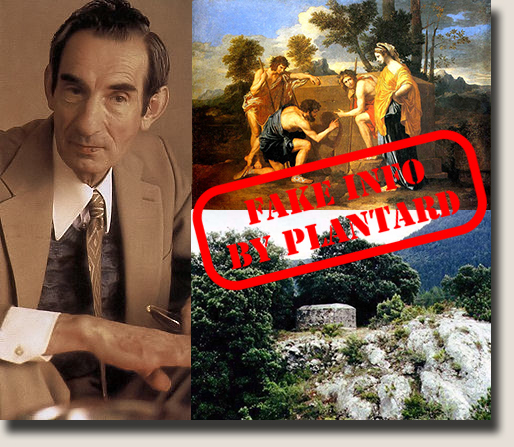
The tomb of Les Pontils and "The Shepherds of Arcadia II" by Poussin
were added to the mystery of Rennes-le-Château as disinformation by Pierre Plantard.
In 1978 the French researcher Franck Marie already pointed out that the Les Pontils monument was only built around the 1930s by Louis Lawrence. The French artist Nicolas Poussin has never been in that southeastern part of France to immortalise the surroundings of Les Pontils in "The Shepherds of Arcadia II". The landscape, building and trees around the tomb of "Rest on the Flight to Egypt with Elephant" are totally different from what is displayed in "The Shepherds of Arcadia II".
Finally regarding the elephant on the canvas: Poussin probably only added the exotic animal in his painting to localise the scenery in Egypt, Africa, where the Holy Family fled to. The elephant was to most suitable beast to portray, because Poussin had seen with own eyes beheld such an impressive animal in Rome in 1630 and for that reason definitely knew how to paint it. The irony of it all is that Don Diego was an Indian elephant and not an African elephant. Poussin's elephant is also clearly an Indian elephant with a hump on its back and small ears, whereas African elephants have hollow back and larger ears. But this small mistake by Poussin I am more than happy to cover with the cloak of charity.
Sources:
- Rice, L. Poussin's Elephant. 2017. Renaissance Quarterly 70, 548–93, Renaissance Society of America.
- Mensior, P. Curiosités et découvertes programmées de la belle histoire. 2020. Association RLC Doc. https://www.rennes-le-chateau-doc.fr/
